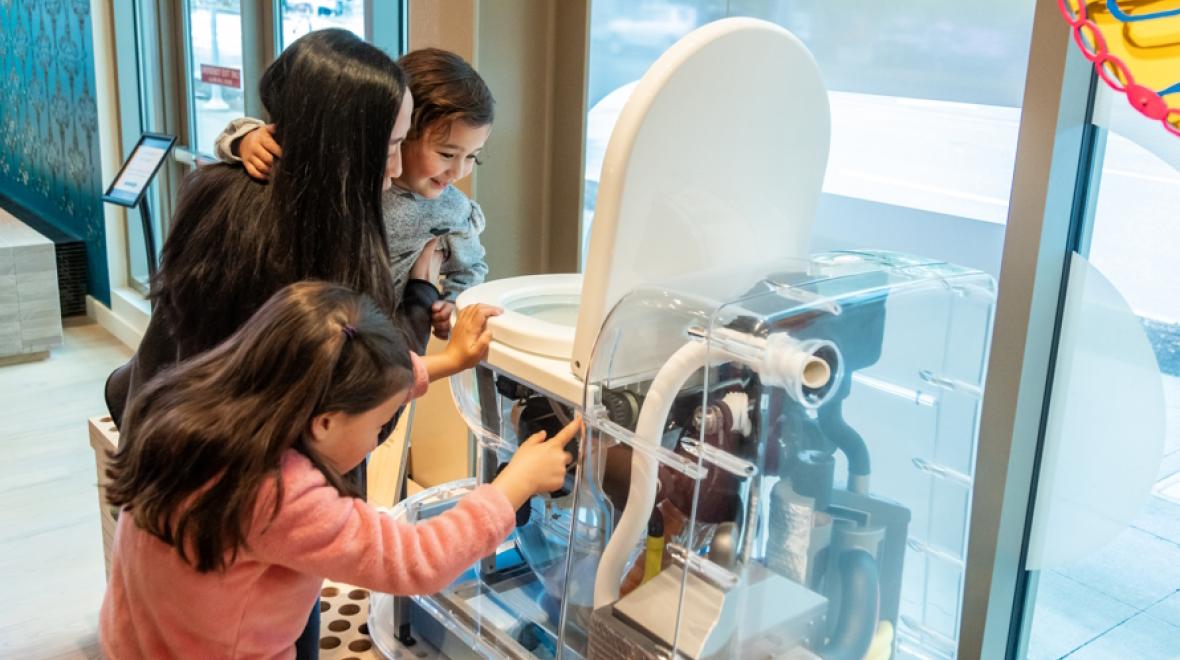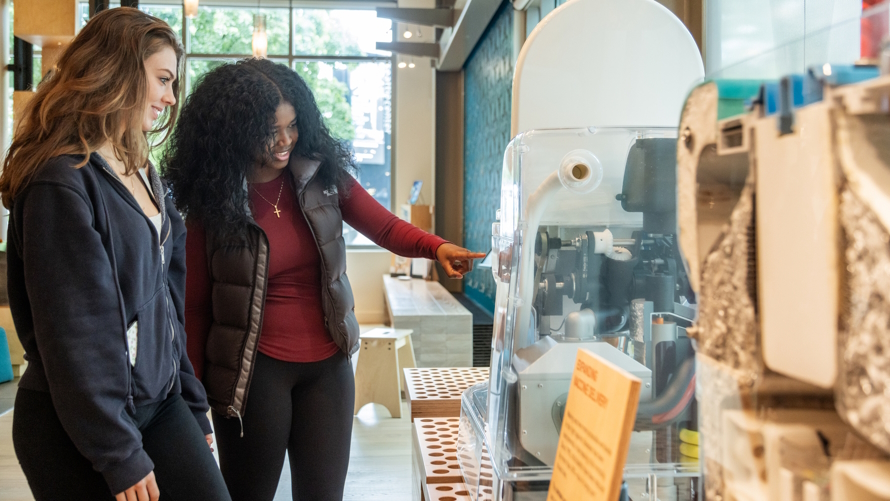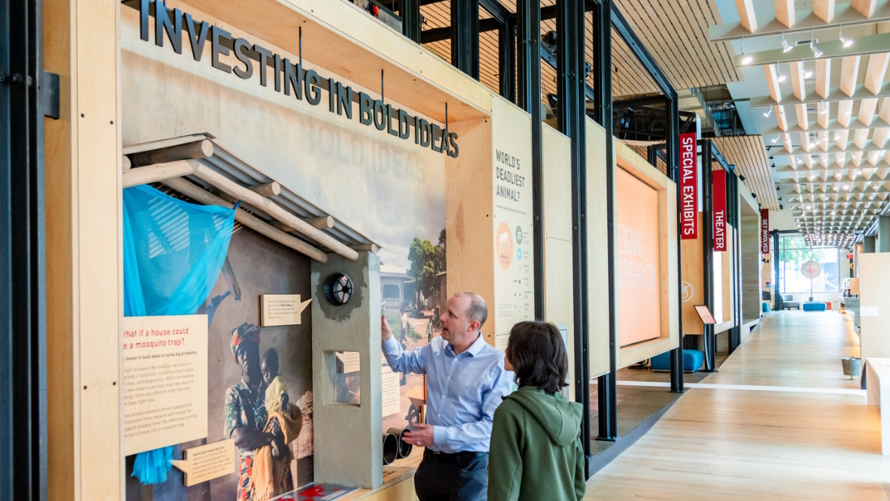
Photo:
Credit: ©Bill & Melinda Gates Foundation/Michael Hanson
Everybody poops. And pees. It’s a biological fact and a basic human activity of life, but the reality is that more than 3.6 billion people lack access to proper sanitation that safely handles waste. Here in the United States, we also face an aging infrastructure that threatens our habitats and clean water as a result.
The result is half the world needs a toilet and the other half could use a better one. We need a better way to go.
Located at Gates Foundation Discovery Center, “A Better Way to Go” is an interactive new exhibition that showcases innovative and critical ways to serve communities locally and globally who suffer sanitation challenges, while taking a lighthearted look at a sometimes embarrassing issue. It asks and answers the question: What do we do with all the poo?
“As students explore the space, it’s important to us that they have a hands-on, fun experience while engaging in critical thinking around this issue.” — Erin Cote, Associate Communications Officer, Bill & Melinda Gates Foundation Discovery Center
New innovations for the world
“A Better Way To Go” opens Feb. 28 to the public and showcases some incredible designs that fuel the change our world needs. Sanitation around the globe, especially in rural areas, will shift with the general acceptance of these innovations, and visiting students and tour groups will have the opportunity to explore them, including the intriguing wooden poop models.
Reinvented toilet machines
The highlight of this exhibit is three amazing toilet innovations that provide clean, safe sanitation in low-resource environments using no water, sewage hookup nor external source of electricity. The super-high tech toilets remove harmful pathogens from human waste and recover valuable resources for the community such as energy, clean water and nutrients. They promote sustainable and profitable sanitation services in poor urban settings and can appeal to everyone in developed and developing nations.

The Gulper
It’s a simple machine but so effective, not to mention interactive, so visitors can experience it in action. The manually-operated pump empties contents from pit latrines as a low-cost, easy-to-use solution that is safe for sanitation workers. The Gulper can pump semi-solid sludge without contaminating those operating it and can be constructed using local materials. It’s been installed in a number of countries including Uganda, Cambodia, Tanzania and Malawi.
SaTo Pan
The SaTo Pan is a low-cost toilet pan invention that mechanically and hydraulically seals pit latrines, making “the go” more comfortable, less smelly and safer, with a lower risk of falls or spreading disease.
Finally, visitors can explore the interactive Water Bar — a fun way to engage with the incredible educators and taste test different water samples, or simply try to make their own oral rehydration solution. More daring participants can even try a smell interaction challenge. Additional activities for groups will be added throughout the run of the exhibit.
“We are closer than ever to building a world where safe sanitation services are a basic human right enjoyed by everyone, not just those with money and access to water.” — Doulaye Kone, Deputy Director, Water, Sanitation & Hygiene, Bill & Melinda Gates Foundation
Dive deeper, learn more
As part of the educational experience, students have the opportunity to dive a little deeper with informational workshops to explore the science and social studies issues that poor sanitation creates. Workshop leaders use activities, games, role playing and stories to help students explore and add depth to their learning experience.
The workshops and tours can be tailored for middle school, high school or college-aged student groups and are held onsite at the Discovery Center or virtually. The exhibit tour lasts between 60 and 90 minutes, with optional workshops designed by grade level.
The new workshops are in addition to the many exciting workshops offered at the Gates Foundation Discovery Center that may be of interest to school groups such as “Fighting Disease Around the World,” “Living in a Climate Changed World” and “The Power of Women’s Equality.”
Be part of the change
For those interested in booking student workshops and sanitation tours, the Discovery Center has created four in-depth lessons that include worksheets (available electronically or as printed supplies) and resources that address culture, sustainability, health and innovations surrounding sanitation issues.

Starting with culture, students and group members observe what toilets (both high quality and undesirable) look like around the world and consider what our reaction is to cultural contexts around sanitation. While this is a shared human need, the lesson clarifies the global inequalities that influence access to sanitation. Participants are challenged to determine and express their cultural toilet preferences and what that means from a global perspective.
Sanitation is a serious sustainability issue due to the water it requires. Students work to calculate individual daily water use as compared to other countries around the world, as well as consider the many ways fresh water is used in the United States. They explore and plan ways to reduce daily water usage with the goal of identifying and choosing new ways to conserve that make our fresh water supply sustainable for the world’s needs.
From cooking oil and trash to feces to pathogens, our toilets and wastewater treatment plants deal with more than just human waste. Tour groups explore the challenges of treating our waste to understand the health concerns around sewer systems and wastewater. As a hands-on activity, students design and engineer a water filter and test it on simulated wastewater. The basic designs of toilets and sewer systems are essentially the same as they were a few hundred years ago. But it’s time to “reinvent the toilet” with innovations that better serve people and our planet. Students are given a design challenge to brainstorm their own toilet — using everyday items such as a pressure cooker or a coffee pot. Students and tour group members then explore reinvented toilet designs through video or images and compare the strengths and weaknesses.
If you go …When: “A Better Way to Go: Toilets and the Future of Sanitation” opens Feb. 28, 2024. Where: Gates Foundation Discovery Center, 440 Fifth Ave. N., Seattle, across the street, on the eastside of Seattle Center, near Memorial Stadium. Hours: Wednesday–Saturday, 10 a.m.–5 p.m. Cost: Free Getting there: Park on a surface lot at Seattle Center, directly across Fifth Avenue, or several nearby parking garages. For public transit, take the Monorail to the Seattle Center or Metro bus routes 3 and 4. How to bring your school group: Register for free Discover Center workshops, such as the Sanitation workshop, online, where you can also find a complete list of available school workshops. |











